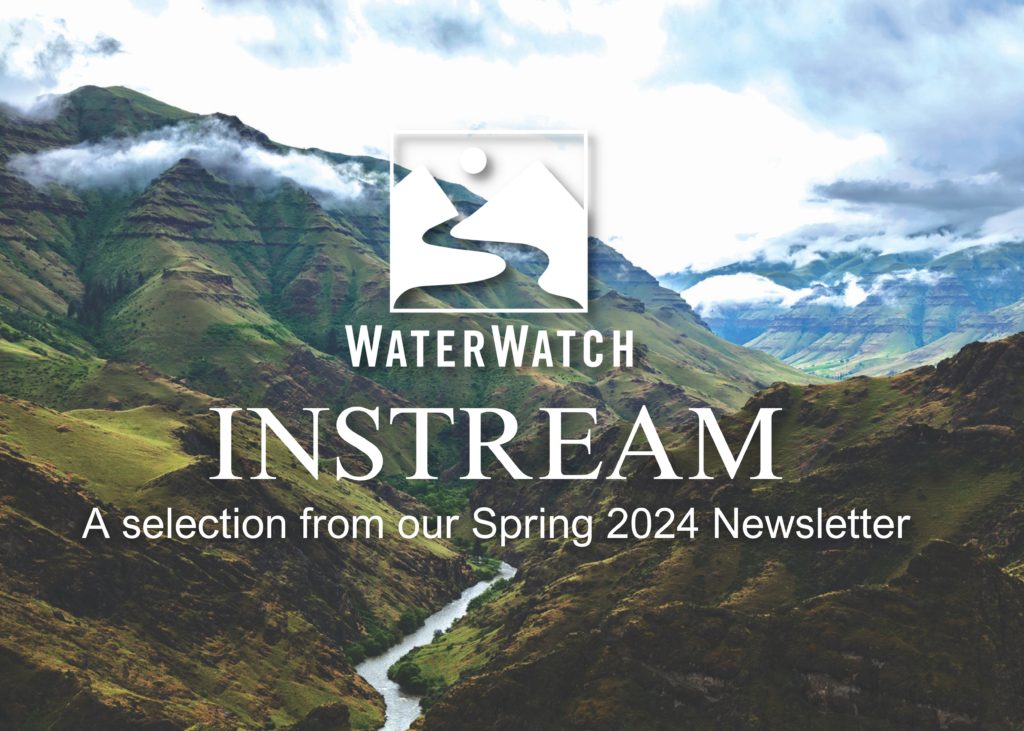April 18, 2024
By Lisa Brown
After an exhaustive and scientifically rigorous process, the Oregon Water Resources Department published proposed groundwater allocation rules reliant upon science and data to implement Oregon’s forward-looking 1955 Ground Water Act — and put Oregon on a more sustainable path to smart, sensible, environmentally-sound groundwater allocation.
On March 1st, the Oregon Water Resources Department (OWRD) issued a draft of new and revised rules to bring the state’s system for issuing new groundwater permits into alignment with Oregon’s landmark 1955 Ground Water Act, implementing a more sustainable path for allocating this vital resource.
To be clear, the newly-proposed rules would apply to new groundwater rights – and would not apply, for example, to exempt uses such as domestic wells.
In simple terms, groundwater is water that is underground. However, much of this groundwater naturally emerges at the surface, and when it does it plays an important role in maintaining wetlands, springs, rivers, and lakes across Oregon. As the impacts of climate change grow more severe on snowpack and drought, groundwater will continue to play an increasingly outsized role in providing for these groundwater dependent ecosystems, including river flows and cold water refugia for native fish, including salmon and steelhead runs.
Oregon first adopted a state water code in 1909, but its focus at the time was on visible surface water, not groundwater. So it was something of a revolutionary step in 1955 when the Oregon legislature enacted its forward-looking Ground Water Act, which required a permit for any “non-exempt uses” like commercial irrigation.
Key to the 1955 Act was a clause that directed the state to only issue a new groundwater permit if the use was determined to “preserve the public welfare, safety and health.” With an eye toward long-term, responsible, sustainable use, key provisions of the 1955 Act included requirements that:
- Groundwater pumping may only be permitted if the pumping is “within the capacity” of the resource.
- The state determines and maintains reasonably stable groundwater levels.
- Adequate and safe supplies of groundwater for human consumption are assured.
Oregon is also required by the 1955 Act to find that water is actually available for the proposed use before a groundwater permit is issued. Oregon may also not issue a new groundwater permit if new pumping would reduce surface water flows in such a way that it would injure surface water rights like irrigation, municipal, or Instream Water Rights that exist to protect streamflow for public uses, like supporting fish runs.
Unfortunately, the rules the OWRD has been using for decades to issue new groundwater permits have not conformed to the forward-looking standards laid out in 1955. The state, for instance, has been issuing groundwater permits without fully accounting for their impacts on surface water, and has injured irrigation, municipal, and Instream Water Rights in the process.
In fact, OWRD has long been in the practice of “defaulting to yes,” or issuing new groundwater rights when it lacked the data to know whether it had already over-appropriated groundwater, or whether the proposed new use was within what’s called the “capacity of the resource.”
OWRD had also not determined or maintained reasonably stable groundwater levels, evidenced most recently by the over-issuing of groundwater permits in the Harney Basin that have caused water levels to plummet by more than 100 feet in some places. At the same time, OWRD has issued prolific amounts of new irrigation pumping rights that have badly impacted domestic wells that people across rural Oregon rely on for drinking water and household needs.
Recognizing the need to modernize its rules, OWRD conducted several public information sessions around the state in the fall of 2022. The agency then embarked on an exhaustive, nearly yearlong process with a Rules Advisory Committee — in which WaterWatch was an active participant — to develop new rules over the course of eight lengthy, in-depth meetings.
The process relied upon science and data to arrive at a set of proposed rules that will put Oregon on a much more sustainable path to groundwater allocation in the future. Interestingly, an ongoing New York Times series on groundwater use around the country continues to demonstrate just how salient and widespread the problem of groundwater over-allocation is.
The newly-proposed OWRD rules align with the 1955 Ground Water Act by modernizing the approach for defining whether water is available to allow issuance of a new groundwater permit. This is to ensure:
- Groundwater levels are reasonably stable under a new set of criteria.
- Pumping under the proposed permit would not interfere with surface water flows and senior surface water rights, including Instream Water Rights.
- The aquifer can produce the water at the requested amount.
Defining the level of data needed to support permit issuance, and establishing a system to ensure that if the state lacks the data needed to make the required site-specific determinations, a finding would be made that no water is available for the requested use, and the application would be denied.
While there are a few items we believe could be stronger, WaterWatch is very supportive of the rules package, and we’re pleased with what the Oregon Water Resource Department has presented. So as the comment and approval process for the new draft rules gets underway, we’d like to ask that you consider writing a comment in support of the proposed rules by May 31st, and if possible, make time to attend one of the remaining public hearings in Central Point on May 16th, and Salem on May 21st (earlier meetings were held in Bend and La Grande).
Some commercial agricultural and municipal interests are pushing back on the efforts to modernize groundwater rules, so it’s important for the state to hear from Oregonians who support sustainable groundwater management. Keep an eye on your inbox and our WaterWatch social media channels as we continue to issue action alerts and related updates as the comment period and public hearings progress.
Visit our corresponding page for more on the Oregon Water Resource Department’s proposed groundwater rule revisions and the schedule of public hearings around the state, including links to the OWRD and other state agencies.
For more, view this article in its original printed form in the spring 2024 issue of WaterWatch’s Instream newsletter.

